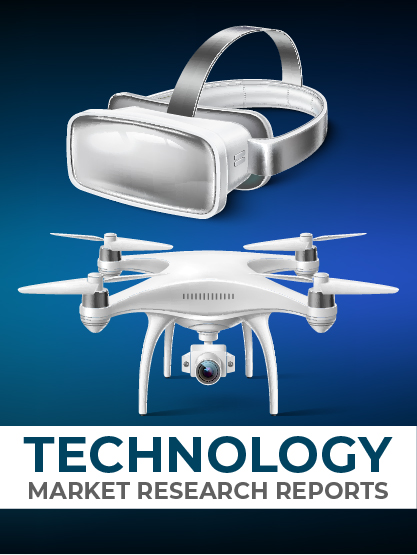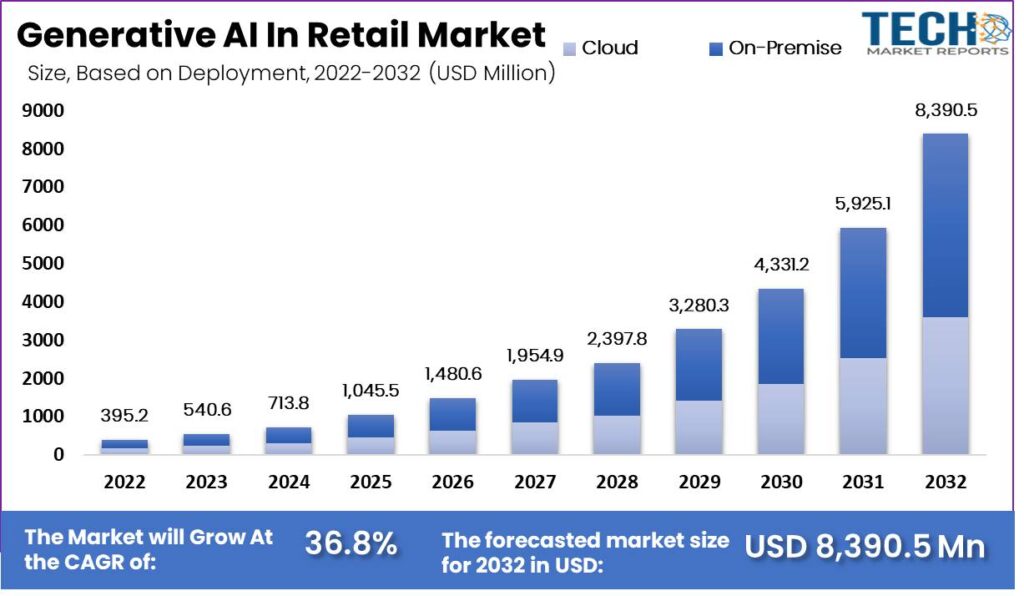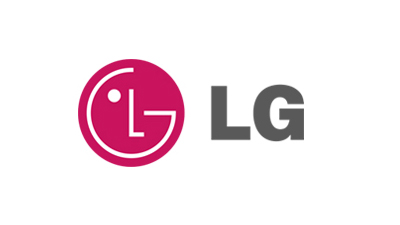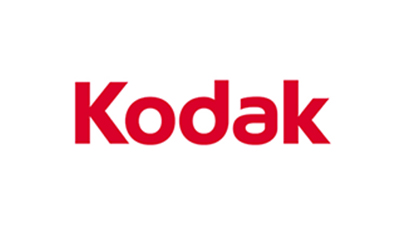
-
Report ID 138058 -
Published Date June 2023 -
Delivery Format PDF/PPT/Word -
Editor's Rating
-
Report Details
Market Overview
The Generative AI in retail Market stood at USD 395.2 Mn in 2022 and the global market is projected to reach USD 8,390.5 Mn by 2032. The global industry is anticipated to expand at a CAGR of 36.8% between 2023 and 2032.
Generative AI in retail refers to the application of generative models, a type of artificial intelligence (AI) technique, to enhance various aspects of the retail industry. Generative AI models are designed to generate new content, such as images, text, or even entire product designs, based on patterns and examples observed during training.

[Please note that the value provided are subject to change in the actual report]
Historical Sales
The global generative AI in retail market is expected to grow at a compound annual growth rate (CAGR) of 25.5% from 2022 to 2028. The market is being driven by the increasing adoption of AI in retail, the growing demand for personalized shopping experiences, and the rising popularity of e-commerce.
Key Takeaways
- Generative AI is a powerful tool that can be used to improve the retail experience in a number of ways.
- Retailers can use generative AI to create personalized shopping experiences for their customers.
- Generative AI can be used to improve customer service by providing customers with quick and accurate answers to their questions.
- Generative AI can be used to optimize operations by automating tasks such as product recommendations and inventory management.
Regional Landscape
The global generative AI in retail market is segmented by region into North America, Europe, Asia Pacific, Latin America, and Middle East & Africa. North America is the leading market for generative AI in retail, followed by Europe and Asia Pacific. The growth of the market in North America is being driven by the increasing adoption of AI in retail, the growing demand for personalized shopping experiences, and the rising popularity of e-commerce.
Some obstacles to the continued growth
- The high cost of generative AI technology
- The lack of skilled professionals who can develop and deploy generative AI solutions
- The regulatory challenges associated with the use of generative AI
Technological Advancements
The continued development of generative AI technology is expected to drive the growth of the market. Some of the key technological advancements that are expected to have a significant impact on the market include:
- The development of more powerful and efficient AI algorithms
- The development of new data sets that can be used to train AI algorithms
- The development of new software tools that can be used to develop and deploy AI solutions
Market Dynamics
Drivers
The major drivers of generative AI in retail market are:
- Increasing demand for personalized shopping experiences
- Rising adoption of e-commerce
- Growing need for improved customer service
- Technological advancements
Restraints
The major restraints of generative AI in retail market are:
- High cost of implementation
- Lack of skilled resources
- Regulatory challenges
Opportunities
The major opportunities of generative AI in retail market are:
- Growing demand for personalized shopping experiences
- Rising adoption of e-commerce
- Growing need for improved customer service
- Technological advancements
Challenges
The major challenges of generative AI in retail market are:
- High cost of implementation
- Lack of skilled resources
- Regulatory challenges
Competitive Arena
- International Business Machines
- Adobe
- Microsoft
- Amazon Web Services
- Intel
- Oracle Corporation
- Nvidia Corporation
- Other Market Players
Recent Developments
Here are some recent developments in generative AI in the retail market:
- In May 2023, Amazon announced the launch of its new AI-powered virtual fitting room, which uses generative AI to create a personalized virtual experience for customers. The virtual fitting room allows customers to try on clothes without having to leave their homes.
- In April 2023, Walmart announced the launch of its new AI-powered product recommendation engine, which uses generative AI to recommend products to customers based on their past purchases and browsing history. The product recommendation engine is designed to help customers discover new products that they might be interested in.
- In March 2023, Target announced the launch of its new AI-powered inventory management system, which uses generative AI to predict demand for products and ensure that stores have the right amount of inventory on hand. The inventory management system is designed to help Target reduce waste and improve customer service.
Market Segmentation
Based on Technology
- Variational Autoencoders
- Generative Adversarial Networks
- Deep Reinforcement Learning
- Recurrent Neural Networks
- Transformer Networks
- Other Technologies
Based on Application
- Product Design & Development
- Visual Merchandising
- Demand Forecasting
- Personalized Marketing
- Fraud Detection
- Inventory Management
- Supply Chain & Logistics
- Other Applications
Based on Deployment
- Cloud
- On-Premise
Based on Industry
- Fashion and Apparel
- Consumer Electronics
- Home Decor
- Beauty and Cosmetics
- Grocery Shops
- Online Platforms
Key Regions
- North America
- The US
- Canada
- Mexico
- Western Europe
- Germany
- France
- The UK
- Spain
- Italy
- Portugal
- Ireland
- Austria
- Switzerland
- Benelux
- Nordic
- Rest of Western Europe
- Eastern Europe
- Russia
- Poland
- The Czech Republic
- Greece
- Rest of Eastern Europe
- APAC
- China
- Japan
- South Korea
- India
- Australia & New Zealand
- Indonesia
- Malaysia
- Philippines
- Singapore
- Thailand
- Vietnam
- Rest of APAC
- Latin America
- Brazil
- Colombia
- Chile
- Argentina
- Costa Rica
- Rest of Latin America
- Middle East & Africa
- Algeria
- Egypt
- Israel
- Kuwait
- Nigeria
- Saudi Arabia
- South Africa
- Turkey
- United Arab Emirates
- Rest of MEA
Frequently Asked Questions
1. What is generative AI?
Generative AI is a type of artificial intelligence that can create new content, such as text, images, and videos, from scratch.
2. What are the benefits of using generative AI in retail?
There are many benefits of using generative AI in retail, including:
- Personalized shopping experiences: Generative AI can be used to create personalized shopping experiences for customers by recommending products and services that are tailored to their needs and preferences.
- Improved customer service: Generative AI can be used to improve customer service by providing customers with quick and accurate answers to their questions.
- Optimized operations: Generative AI can be used to optimize operations by automating tasks such as product recommendations and inventory management.
3. What are the challenges of using generative AI in retail?
There are also some challenges associated with using generative AI in retail, including:
- High cost: Generative AI technology is still in its early stages of development, and the cost of implementing these solutions can be high.
- Lack of skilled professionals: There is a shortage of skilled professionals who can develop and deploy generative AI solutions.
- Regulatory challenges: There are some regulatory challenges associated with the use of generative AI, such as the potential for the technology to be used to create fake content.
4. What are the future trends for generative AI in retail?
The future trends for generative AI in retail are very promising. As the technology continues to develop and the cost of implementation decreases, we can expect to see generative AI being used in more and more ways to improve the customer experience. Some of the specific trends that we can expect to see include:
- Increased use of generative AI for personalized shopping experiences: We can expect to see generative AI being used to create more personalized shopping experiences for customers. This will be done by recommending products and services that are tailored to the customer’s needs and preferences.
- Improved customer service: We can also expect to see generative AI being used to improve customer service. This will be done by providing customers with quick and accurate answers to their questions.
- More efficient operations: Generative AI can also be used to make operations more efficient. This will be done by automating tasks such as product recommendations and inventory management.
5 Predictions about the Future
- To create personalized shopping experiences that are tailored to each individual customer’s needs and preferences.
- To improve customer service by providing customers with quick and accurate answers to their questions.
- To optimize operations by automating tasks such as product recommendations and inventory management.
- To create new products and services that meet the needs of a changing marketplace.
- To transform the retail industry by creating a more personalized, efficient, and engaging shopping experience.
-
Table Of Content
Research Insights & Deliverables
 Development and Future Forecast
Development and Future Forecast Competitive benchmarking
Competitive benchmarking Company Revenue Statistics
Company Revenue Statistics Rising Regional Opportunities
Rising Regional Opportunities Technology Trends and Dynamics
Technology Trends and Dynamics Technology Assessment
Technology Assessment
-
Inquiry Before Buying
Research Insights & Deliverables
 Development and Future Forecast
Development and Future Forecast Competitive benchmarking
Competitive benchmarking Company Revenue Statistics
Company Revenue Statistics Rising Regional Opportunities
Rising Regional Opportunities Technology Trends and Dynamics
Technology Trends and Dynamics Technology Assessment
Technology Assessment
-
Request Sample
Research Insights & Deliverables
 Development and Future Forecast
Development and Future Forecast Competitive benchmarking
Competitive benchmarking Company Revenue Statistics
Company Revenue Statistics Rising Regional Opportunities
Rising Regional Opportunities Technology Trends and Dynamics
Technology Trends and Dynamics Technology Assessment
Technology Assessment














